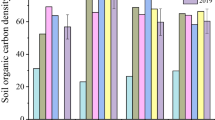Abstract
The vigor of Norway spruce stands in the Bohemian Forest of Austria was correlated with site factors, informations on historic land use, and chemical properties of the soils and spruce needles. The study confirmed that trees on west exposed slopes and plateaus in higher elevation have lower crown densities. The soils in the area are generally low in base saturation. Historical land use, such as litter raking, grazing and burning of biomass for potash led to nutrient depletion. Increasing deposition of atmospheric N during the last decades alleviated N stress, but increased Ca and Mg stress. N∶Mg ratios in needles of declining stands are wide, indicating N induced nutritional imbalances. PH values in the mineral topsoil are very low on W-slopes and plateaus. Measurements of pollutant deposition at three different sites indicate a strong influence of aspect and elevation on input rates. In a southwest exposed stand and a stand on a hilltop, facing the prevailing winds, substantially more S and N was recovered in the throughfall than in northeast exposed stand. Deposition rates in the open did not differ significantly. High NO3 − concentrations in the soil solution of the southwest exposed site indicate N saturation of the system. In order to test the hypothesis that mineral deficiency and nutritional disorders contribute to the poor vigor of these stands, fertilizer experiments were established. Fertilization with a combination of an organic fertilizer (BACTOSOL**)) and a magnesite fertilizer (BIOMAG*)) significantly improved crown density, growth, seed viability, and mineral nutrition as inferred from foliar analysis. NO3 − leaching in the combined BACTOSOL+BIOMAG treatment increased during the first and second growing season after fertilization but leveled off to values typical for the control plots after three years. Mg content of the soil solution increased both in the BIOMAG and the combined BACTOSOL+BIOMAG treatment. These experiments show that the nutritional status and the resilience of declining forests in the Bohemian Forests of Austria can be easily improved by proper fertilizer treatment.
Similar content being viewed by others
References
Agren, G.I. and Bosatta, E.: 1988, Environmental Pollution 54, 185.
Bitterlich, W.: 1948, Allg. Forst- und Holzwirtschaftliche Zeitung 59, 4.
Blum, W.E.H, Spiegel, H., and Wenzel W.: 1989, Bodenzustandsinventur; Konzeption, Durchführung und Bewertung, Wien, 95 p.
Falkengren-Grerup, U.: 1987, Environmental Pollution 43, 79.
Fuchs, G. and Thiele, O.: 1968, Erläuterungen zur Übersichtskarte des Kristallins im westlichen Mühlviertel und im Sauwald, Oberösterreich, Geologische Bundesanstalt, Wien, 96p.
Guderian, R., Klumpp, A., and Küppers, K.: 1987, Verhandlungen der Gesellschaft für Ökologie 16, 311.
Glatzel, G., Haselwandter, K., Katzensteiner, K., Sterba, H., and Weißbacher, J.: 1991, Water, Air, and Soil Pollut. In press.
Hallbäcken, L. and Tamm, C.O.: 1986, Scand. J. For. Res. 1, 219.
Hüttl, R.F.: 1985, Freiburger Bodenkundliche Abhandlungen 16, 196p.
Hüttl, F.: 1986, The Fertiliser Society Proceedings 250.
Institut für Forstliche Standortsforschung: 1971, Standortskartierung der Reviere nördlich der Groβen Mühl des Forstbetriebes des Stiftes Schlägl, Revier Obernhof, Wien, 115 p.
Jelem, H.: 1976, Mitt. der FBVA Wien 117, 164 p.
Katzensteiner, K., Glatzel, G., and Kazda, M.: 1991, Forest Ecology and Management, In press.
Kazda, M.: 1990, Forstliche Schriftenreihe der Univ. f. Bodenkultur, Wien, 3, 144 p.
Lindebner, L.: 1990, Der Bodenzustand in Buchenwäldern des Wienerwaldes, FIW-Forschungsbericht 1990/2, Wien, 154 p.
Matzner, E.: 1988, Berichte des Forschungszentrums Waldökosysteme/Waldsterben Reihe A, 40, 217p.
Nilsson, J. and Grennfeldt, P., ed.: 1988, Critical loads of sulphur and nitrogen. Miljorapport 15. Stockholm, 418 p.
Pollanschütz, J.: 1985. Instruktionen für die Feldarbeit der Waldzustandsinventur nach bundeseinheitlichen Richtlinien 1984–1988, Forstliche Bundesversuchsanstalt, Wien, 69 p.
Rachoy, W.: 1971, Cbl f. d. ges. Forstwesen 88, 1, 26.
Shriner, D.S., Heck, W.W., McLaughlin, S.B., Johnson, D.W., Joslin, J.D., and Peterson, C.E.: 1990, Responses of vegetation to atmospheric deposition and air pollution, State-of-Science/Technology Report No. 18, National Acid Precipitation Assessment Program, Washington D.C. (in prep.).
Stöhr, D.: 1984, Waldbodenversauerung in Österreich. Veränderungen der pH-Werte von Waldböden während der letzten Dezennien, Wien, 165p.
Zech, W. and Popp, E.: 1983, Forstw. Cbl 102, 50.
Zöttl, H.W.: 1990, Forstw. Cbl. 109, 130.
Author information
Authors and Affiliations
Rights and permissions
About this article
Cite this article
Katzensteiner, K., Glatzel, G., Kazda, M. et al. Effects of air pollutants on mineral nutrition of Norway spruce and revitalization of declining stands in Austria. Water Air Soil Pollut 61, 309–322 (1992). https://doi.org/10.1007/BF00482613
Issue Date:
DOI: https://doi.org/10.1007/BF00482613




